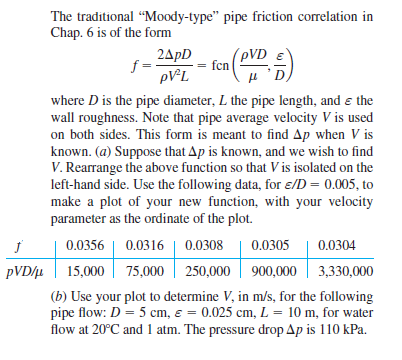The traditional "Moody-type" pipe friction correlation in Chap. 6 is of the form 2APD f = pVL (pVD и "D, where D is the pipe diameter, L the pipe length, and e the wall roughness. Note that pipe average velocity V is used on both sides. This form is meant to find Ap when V is known. (a) Suppose that Ap is known, and we wish to find V. Rearrange the above function so that V is isolated on the left-hand side. Use the following data, for e/D = 0.005, to make a plot of your new function, with your velocity parameter as the ordinate of the plot. 0.0356 | 0.0316 | 0.0308 pVD/u | 15,000 | 75,000 | 250,000 | 900,000 | 3,330,000 0.0305 0.0304 (b) Use your plot to determine V, in m/s, for the following pipe flow: D = 5 cm, e = 0.025 cm, L = 10 m, for water flow at 20°C and 1 atm. The pressure drop Ap is 110 kPa.
The traditional "Moody-type" pipe friction correlation in Chap. 6 is of the form 2APD f = pVL (pVD и "D, where D is the pipe diameter, L the pipe length, and e the wall roughness. Note that pipe average velocity V is used on both sides. This form is meant to find Ap when V is known. (a) Suppose that Ap is known, and we wish to find V. Rearrange the above function so that V is isolated on the left-hand side. Use the following data, for e/D = 0.005, to make a plot of your new function, with your velocity parameter as the ordinate of the plot. 0.0356 | 0.0316 | 0.0308 pVD/u | 15,000 | 75,000 | 250,000 | 900,000 | 3,330,000 0.0305 0.0304 (b) Use your plot to determine V, in m/s, for the following pipe flow: D = 5 cm, e = 0.025 cm, L = 10 m, for water flow at 20°C and 1 atm. The pressure drop Ap is 110 kPa.
Elements Of Electromagnetics
7th Edition
ISBN:9780190698614
Author:Sadiku, Matthew N. O.
Publisher:Sadiku, Matthew N. O.
ChapterMA: Math Assessment
Section: Chapter Questions
Problem 1.1MA
Related questions
Question

Transcribed Image Text:The traditional "Moody-type" pipe friction correlation in
Chap. 6 is of the form
2APD
f =
pVL
(pVD
и "D,
where D is the pipe diameter, L the pipe length, and e the
wall roughness. Note that pipe average velocity V is used
on both sides. This form is meant to find Ap when V is
known. (a) Suppose that Ap is known, and we wish to find
V. Rearrange the above function so that V is isolated on the
left-hand side. Use the following data, for e/D = 0.005, to
make a plot of your new function, with your velocity
parameter as the ordinate of the plot.
0.0356 | 0.0316 | 0.0308
pVD/u | 15,000 | 75,000 | 250,000 | 900,000 | 3,330,000
0.0305
0.0304
(b) Use your plot to determine V, in m/s, for the following
pipe flow: D = 5 cm, e = 0.025 cm, L = 10 m, for water
flow at 20°C and 1 atm. The pressure drop Ap is 110 kPa.
Expert Solution
This question has been solved!
Explore an expertly crafted, step-by-step solution for a thorough understanding of key concepts.
This is a popular solution!
Trending now
This is a popular solution!
Step by step
Solved in 3 steps with 7 images

Recommended textbooks for you

Elements Of Electromagnetics
Mechanical Engineering
ISBN:
9780190698614
Author:
Sadiku, Matthew N. O.
Publisher:
Oxford University Press

Mechanics of Materials (10th Edition)
Mechanical Engineering
ISBN:
9780134319650
Author:
Russell C. Hibbeler
Publisher:
PEARSON

Thermodynamics: An Engineering Approach
Mechanical Engineering
ISBN:
9781259822674
Author:
Yunus A. Cengel Dr., Michael A. Boles
Publisher:
McGraw-Hill Education

Elements Of Electromagnetics
Mechanical Engineering
ISBN:
9780190698614
Author:
Sadiku, Matthew N. O.
Publisher:
Oxford University Press

Mechanics of Materials (10th Edition)
Mechanical Engineering
ISBN:
9780134319650
Author:
Russell C. Hibbeler
Publisher:
PEARSON

Thermodynamics: An Engineering Approach
Mechanical Engineering
ISBN:
9781259822674
Author:
Yunus A. Cengel Dr., Michael A. Boles
Publisher:
McGraw-Hill Education

Control Systems Engineering
Mechanical Engineering
ISBN:
9781118170519
Author:
Norman S. Nise
Publisher:
WILEY

Mechanics of Materials (MindTap Course List)
Mechanical Engineering
ISBN:
9781337093347
Author:
Barry J. Goodno, James M. Gere
Publisher:
Cengage Learning

Engineering Mechanics: Statics
Mechanical Engineering
ISBN:
9781118807330
Author:
James L. Meriam, L. G. Kraige, J. N. Bolton
Publisher:
WILEY